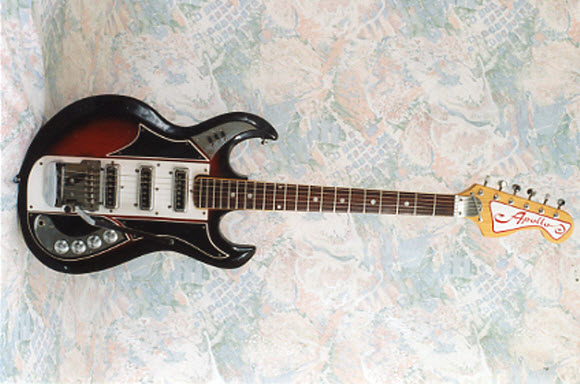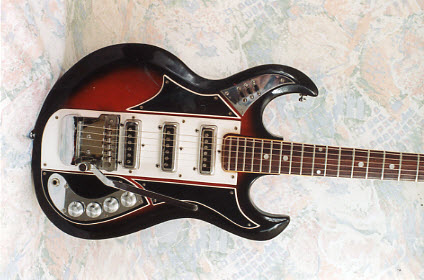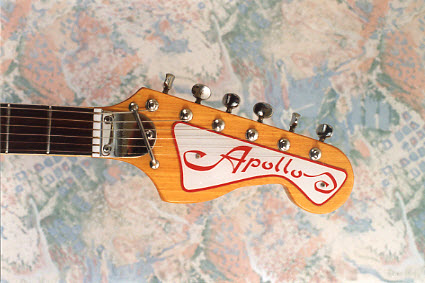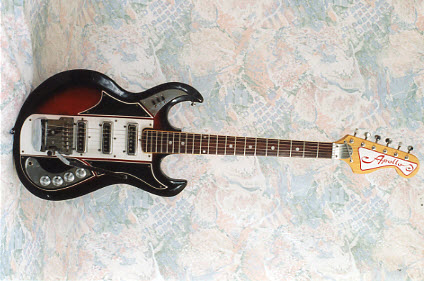
One cool thing about liking oddball old guitars is they always contain hope…and a challenge. By which I mean, no matter how obscure or exotic, you always live with hope that you’ll someday figure out what the heck they are and thrive on the challenge of trying to do so. At least that’s been my repeated experience over the last quarter century or so of playing guitar detective.
That being said, this Apollo Deluxe was kind of the exception that proved the rule, in that it followed a reverse pattern, sort of backing into discovery. While I didn’t really know what it was when I found it, I did have some idea of what it might be, or at least ought to be! I knew that the Grecian-god-themed Apollo brand was a part of the St. Louis Music (SLM) family of instruments, so all I had to do was locate it within the pantheon (SLM’s better-known brand was Electra, another Greek god).
St. Louis Music reflects one of those hazy back-stories in American (and actually international) guitar history that involve the murky world of distributors, which few people really understand. Distributors—or “jobbers”—were part of the middleman structure in the music business that bought instruments from the manufacturers (usually what we call “mass manufacturers,” like Kay or Harmony), marked them up, and got them to the music stores,department stores, and studios where they would be retailed to you and me. They’re the wringers because the guitars they bought might say Kay, but they might just as well say Cromwell or Custom Kraft. This latter was the brand used by SLM on guitars produced for them by Kay during the 1950s and ‘60s.

Vintage 1967 Apollo Deluxe Electric Guitar
A roughly equivalent—though somewhat more Byzantine—business model developed in Japan following World War II. How much that was a result of American governorship would be an interesting subject to study. Guitar manufacturers—some of whom had been active before the War—sprang up, similar to a Kay or Harmony. They sold their products to “trading companies,” whose job was to distribute domestically and to interface with foreign importers, who would then either be a distributor in its own country, or sell to other distributors, or both. (To make things worse, the trading companies may or may not have owned an interest in the manufacturing companies; can you say CMI and Gibson?) You can see why sorting this all out is not always easy!
Japanese guitars made significant inroads into the American market as the 1960s progressed. And not coincidentally, American mass manufacturing declined accordingly, although I think this was more a combination of management stagnation and cultural chauvinism than anything else. The global economy was still emerging and Depression-era-trained managers didn’t get it. There’s very little difference (read “improvement”) between a 1962 and a 1967 Kay, Harmony, or Valco guitar.

Vintage 1967 Apollo Deluxe Electric Guitar
SLM had sourced guitars from Kay for a long time but it, too, was drawn to the Japanese makers. SLM was big enough to be important players in the music industry, big enough to see the writing on the wall. They may even have had inside information that all was not rosy at Kay, which was purchased by Seeburg in 1965 and then Valco in 1967. By 1968 both Valco and Kay had gone belly-up.
Anyhow, this model shows up in an undated SLM catalog probably from around 1967. Or at least a two-pickup version does, called the Deluxe 2235. Clearly this was inspired by—or actually meant to compete with—a Burns Bison. At that time the Japanese were copying the European guitars that had been the “budget” alternatives earlier in the ‘60s. Thus, this is an early “copy” guitar. If you’ve overcome the usual prejudices of many older guitar enthusiasts, you know that this is a pretty decent guitar, once it’s properly set up. Poor set-up was the common problem of the time for these guitars. Look, these pickups ain’t DiMarzios, the switching is kind of sucky, and Japanese wiring was really small gauge, so it may not survive well, but these have their own sound and are great fun.
Even though Kay went out of business in ’68, SLM continued to offer Custom Krafts until 1970. Whether or not those were left-over stock or assembled by SLM from parts is unknown. By 1968 they were already pretty dated designs in any case, so probably not selling well. The SLM Apollos were probably not imported in large quantities, based upon how many you see: not many!
SLM, of course, would go on to introduce The Electra guitar, a copy of the Ampeg Dan Armstrong Plexiglas guitar in 1970, and Electra would be their primary brand for electrics (Alvarez for acoustics) until 1984, and they would be a major force in the importation and distribution of guitars from Asia. This Apollo represents a fascinating clue in deciphering that process!


Electra is a character in a greek tragedy, not a goddess.LOL.
I remember, in about 1964, seeing an Ibanez guitar with that same body shape and four pickups. As for the Greek mythological connection, yes, Apollo was definitely a god; the god of the sun and of music–how appropriate for a guitar brand, eh? But Electra wasn’t a god–there were actually three characters in Greek mythology named Electra, all of them female. Two of them were minor goddesses–one was an ocean goddess, and the other was an actual star; one of the Pleiades. The third Electra was a mortal woman, the daughter of Agamemnon and Clytemnestra. I’m not aware of any other Greek mythological names being used for any other guitars–well, Harmony made a Stratotone Jupiter, but he was a Roman god–the Greeks called him Zeus, and “Stratotone Zeus” doesn’t quite have the same ring, does it!
I have this exact guitar in absolute great condition that I received for Christmas when I was 15 years old. It has been set up and plays as well as any Fender or Gibson I’ve ever owned . I believe I still have the original plastic case,although the interior is pretty rough. I would be extremely interested in knowing it’s value. Also if I were to send pictures and any serial or model numbers , I have a late 60’s model Gibson that I believe is a TS125. I’m not familiar enough with that era of instruments to be sure,do you possibly have any information on era of the Gibsons
Hello, I had the same exact guitar when I was 15 years old. That would have been in 1975. I kept the guitar until I was in my mid 30’s and lost in in a pawn shop in Alabama. That was really a sweet playing guitar. I started playing guitar (by ear) at the age of 8. They say hind-sight is 20/20. I regret ever taking the Apollo to the pawn shop. This page really brings back memories,
Thanks,
Tuffy
I got one of these when I was 13 for Christmas in 1967 . My mom and dad bought it new at a local music shop in the suburbs of Detroit.I learned to play basic chords on it. We moved a few times after that and the guitar disappeared, wish I had it now, as it would be very sentimental to me. The Apollo name on the guitar follows the NASA missions and our journey to the moon that eventually happened in 1969
The Apollo 2235 was my first electric guitar I played it for 20 years until the wiring needed to be replaced I still have it in the original case and reading the articles about the guitar has me considering having the wiring fixed.
this guitar sounds great, plays well, and really is a beautiful piece of art. My guitar has trouble with the electrical parts on the inside though. It almost is like a wire broke off the bond somewhere and i need to get it fixed.